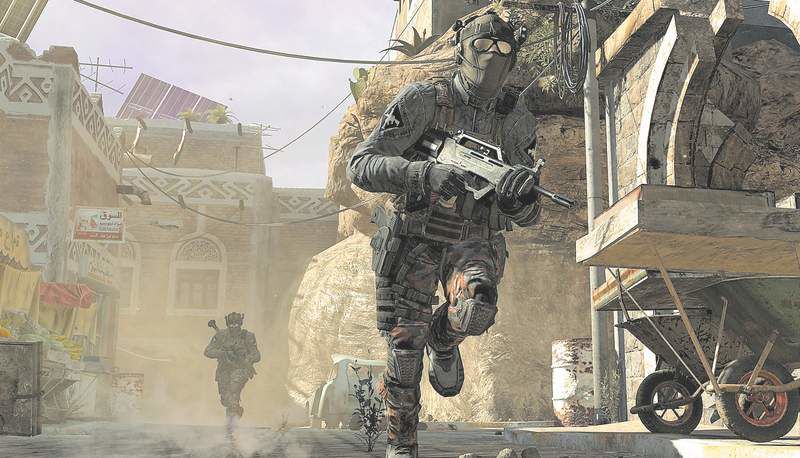Good and bad in ‘Black Ops II’
Published 4:00 am Friday, November 23, 2012

- “Call of Duty: Black Ops II” finally introduces some significant changes to the game's single-player formula.
“Call of Duty 2” kicked off this console generation when it released alongside the Xbox 360, and the series has been an annual juggernaut ever since. This sustained popularity has put the series in a tough spot creatively, as drastic changes to the formula might turn off longtime fans. With the first “Black Ops,” Treyarch demonstrated it was willing to take risks by shaking up numerous multiplayer conventions. Fans loved the new features, and the developer has shifted its focus to campaign changes for “Black Ops II.” Some of these risks pay off, and others are faulty despite their ambition.
One of the most frequent critiques of the series’ campaigns revolves around their restricting linearity. Treyarch has countered this in two ways with “Black Ops II”: presenting the player with narrative-changing decisions (both obvious and subtle), and adding the new sandbox Strike Force missions.
During my six hours with the campaign, I sometimes didn’t even realize how my actions had shaped the situations. You are occasionally presented with immediate choices like, “Do you want to kill this guy or not?” but others aren’t as overt. As you enter one area near the middle of the campaign, your enemies are desperately attempting to burn evidence of some sort. Depending on how quickly you kill them, you might gain some information that will assist the overall war effort. These decisions don’t affect the grand scheme of things, but many cutscenes and in-game scenarios can be altered based on your actions. The weight of your decisions isn’t on the level of a game like “Heavy Rain,” but the system had me talking to others about their experiences in a way I had never done before with this series.
Interspersed between the story’s chapters are the new Strike Force missions. These are undoubtedly the weakest part of the single-player component. The idea of integrating sandbox stages with light RTS elements could have been a great way to shake up the standard gameplay. Instead, these stages are full of frustration as you attempt to control your AI teammates. Ordering my squads around via the overhead tactical view proved to be a fruitless effort, as they rarely reacted to my commands. At one point late in the game, I even had to restart an entire Strike Force mission because of a glitch that wouldn’t allow me to perform the final required action.
Strike Force missions are a pain, and though they are not required for progression, they have a major impact on your ending. If you take them out of the equation, the “Black Ops II” campaign is on par with previous entries. Hopping between the 1980s and 2025, it tells the story of the original game’s Alex Mason and his son David. The plot quickly gets convoluted, but the main threads are easy to follow and are ultimately rewarding. Everything moves along at a breakneck pace, big set piece moments punctuate the action, and Raul Menendez proves to be one of the best antagonists in the series.
With such a focus on introducing new elements to the campaign, it seems that multiplayer was approached with more of an “if it ain’t broke” mentality. Treyrach made one big tweak when it comes to loadouts: the new Pick 10 system, which allows for increased customization options. Players are allowed to hit the battlefield with 10 points in their loadout. Gun attachments, perks, grenade types, secondary weapons, and new wild card bonuses each take up a point. If you want to take the fight to your enemy with a decked-out LMG, you can equip up to three attachments with the use of a wild card bonus. If you’d rather create an ultra-speedy class for capture the flag matches, you can activate wild cards that allow for two perks in each slot. With those active, you’re free to head into battle with six speed-oriented perks. The system is interesting, but I ultimately found it less exciting than the currency system and contracts introduced in the original Black Ops and scrapped for this sequel.
“Black Ops II” gives multiplayer fans countless tweaks and changes to the formula to keep them occupied until next year’s inevitable installment. New league matches are tailored to the e-sports community, and these open up every unlockable from the start in the interest of fairness. They also eliminate random elements from maps, such as moving environmental objects. Stat-tracking elements of “Call of Duty Elite” are now free, so everyone who owns the game has access to heat maps and extensive records.
Despite some frustrations, “Black Ops II” is yet another massive, polished, finely tuned entry in a series that shows no signs of slowing down. Even if Treyarch misses the mark on occasion, I respect the developer for taking chances with a series that would sell just fine if it stuck with the status quo.
‘CALL OF DUTY: BLACK OPS II’
8.5 (out of 10)
PlayStation 3, Xbox 360
Activision, Treyarch
ESRB rating: M
Top 10
On the PS3
The editors of Game Informer Magazine rank the top PS3 games for the month of November:
1. “Assassin’s Creed III,” Ubisoft
2. “XCOM: Enemy Unknown,” 2K Games
3. “Need For Speed: Most Wanted,” Electronic Arts
4. “WWE ’13,” THQ
5. “Hitman: Absolution,” Square Enix
6. “Borderlands 2,” 2K Games
7. “Dishonored,” Bethesda
8. “FIFA 13,” EA Sports
9. “NBA 2K13,” 2K Sports
10. “Call of Duty: Black Ops II,” Activision
Game Informer Magazine
Gadgets
Sony’s new Wireless Stereo Headset
In September, Sony introduced the PS3 Pulse Wireless Stereo Headset, and the Japanese company nails it. This is the device your ears have been waiting for.
The Pulse fits comfortable on the head. It’s hefty but not overbearing. The cups envelop the ears snugly and it’s only after four or five hours of constant wear that you’ll need to take them off either because they do start to hurt after a while or the battery will run dry. Battery life isn’t a strength of the headset.
What it does well though is produce crystal-clear sound. Gunshots sound like they whiz by your head. The clickety-clack of shoes on pavement reverberates in the earpads. Suffice to say, the audio is superb and rivals that of my favorite set of cans the Turtle Beach Ear Force PX5 thanks partly to the 7.1 virtual surround sound that Sony added to the device.
Best of all, you don’t have to use this with the PS3. The Pulse comes with the wires to connect it any device with a 3.5 mm jack.
At $149, the Pulse is $50 more expensive than last year’s model, but you get more for the price tag. It’s a sound buy for anyone with a PS3 looking for a headset that can be used for gaming and beyond.
— Gieson Cacho, Contra Costa Times






